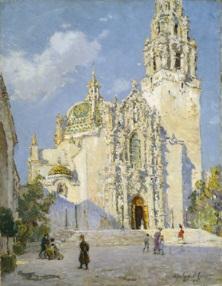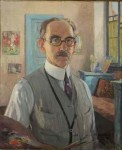
Colin Campbell Cooper
American, 1856-1937
California State Building, San Diego Exposition, 1916
oil on canvas
26 x 20 1/8 in.
SBMA, Gift of the Family of the Artist
1943.3

Colin Campbell Cooper, Self-portrait, ca. 1922
“My own work . . . reflects, I hope, my impressions of the many and diverse things which I have found of interest to record, seen through a technical training. It requires no key or chart to explain its meaning, and for that matter, neither has the art of the past needed an interpreter.” (Colin Campbell Cooper, in a July 1933 letter, quoted in Hansen catalogue introduction.)
RESEARCH PAPER
Colin Campbell Cooper’s “California State Building, San Diego Exposition, 1916” exemplifies the artist’s longstanding focus on monumental architecture. This building, which incorporates elements of Baroque ecclesiastical architecture but which was never used for sacred purposes, dominates the composition. The canvas itself is vertical, and this format serves to highlight the tower, the top of which Cooper truncated. Cooper painted from a vantage point in the El Prado courtyard, facing the south façade. Afternoon sun washes over the structure, with Cooper making skillful use of light and shadow to bring out the Baroque intricacies of the architecture. The foreground and the section of El Prado at left are in shadow. The doors stand invitingly open while fair-goers walk out of the shadow, into the sunlight, and into the building. Cooper used the short brushstrokes and seemingly casual depiction characteristic of Impressionism. Above and behind the building, a few puffy white clouds swirl across an azure sky. The mood is warm, drawing the viewer into the enjoyment of a late-spring afternoon in Southern California.
Cooper was born in Philadelphia on March 8, 1856. He began his career at the Pennsylvania Academy of the Fine Arts, studying under Thomas Eakins. During 1889 and 1890 Cooper studied at three private art schools in Paris, one of which was the Academie Julian (Gerdts et al., p. 26). The Julian was non-hierarchical, relaxed, and open to new ideas, a liberal counterpoint to the establishment Ecole des Beaux-Arts. The Julian faculty did not attempt to impose a particular style on their students (Russell). Among Cooper’s instructors at the Julian was William Bougereau. (Gerdts and Solon, p. 14) SBMA owns his 1869 “Portrait of Mademoiselle Martha Hoskier”. Cooper is one of at least two-dozen American Impressionist painters who studied at the Julian (Hansen, introduction). During his Paris sojourn, he painted mostly Barbizon-style landscapes. Cooper developed his Impressionist style while traveling in Europe in the years around the turn of the twentieth century (Lowrey). Lowrey compares one of Cooper’s New York paintings to “urban vistas of Claude Monet and Camille Pissarro, whose work Cooper would have seen in Paris.” While living in New York Cooper knew Childe Hassam, who was also an Academie Julien alumnus, and who also influenced Cooper’s impressionist style.
Cooper and his wife Emma initially resided in Philadelphia but moved to New York City in 1904. Colin and Emma took an extended trip to California in 1915 and 1916, beginning with their visit to the Panama-Pacific International Exposition, held in San Francisco during 1915. By April 1916 they were in Southern California, first Los Angeles and then San Diego (Gerdts and Solon, pp. 87-88). New York continued to be their home until 1921, when Cooper moved to Santa Barbara following Emma’s death (Gerdts and Solon, p. 54). In Santa Barbara, Cooper taught at the Santa Barbara School of the Arts, founded the year before his arrival (Gerdts and Solon, p. 108). A few months before his passing at the age of 81, Cooper had the original idea to establish the Santa Barbara Museum of Art. On Sunday, July 25, 1937 the News-Press published a letter from Cooper, urging that the old Post Office building be converted to an art museum. He died on November 6. His obituary published in the News-Press the following day, states: “Mr. Cooper’s credo was beauty. He lived that credo and it was the keynote of his art.”
“California State Building” fits squarely within the subject category for which Cooper is best known—depictions of monumental works of architecture. He began to build his reputation as an architectural painter as early as 1896, with “The Pageant at Bruges”, in which that Belgian city’s Gothic city hall dominates the composition (Gerdts and Solon, pp. 16-18). Cooper made many paintings over several decades of European Gothic cathedrals, and shortly after 1900 began the body of work for which he is best known today —studies of skyscrapers in New York and other American cities that were growing increasingly upward (Gerdts and Solon, pp. 21-22). Though it never was a church, the California State Building, designed by Bertram Goodhue, looks very much like one. Gerdts and Solon describe the building as “part Gothic cathedral, part Baroque church, part Hagia Sophia, part Mexican cathedral—that somehow achieves harmony and balance.” (p. 95)
The Panama-California Exposition opened in San Diego on New Year’s Day, 1915 and ran for two years (Reynolds). By early May of 1916, Cooper was sketching at the fairgrounds (Gerdts and Solon, p. 90). The fairgrounds live on today as a portion of Balboa Park, and the California State Building houses the San Diego Museum of Man.
In addition to this painting, the Museum holds five other Cooper works: “Palace Gate, Udaipur, India” (1914); “Segovia, Spain” (1924); “Venetian Scene” (1902-1912); “Interior of St. Marks” and “Interior of Malines Cathedral.” The latter two are gouache on paper, the other paintings are in oil.
Prepared for the Santa Barbara Museum of Art Docent Council by
David Reichert, February 2016.
Bibliography
AskArt, “Colin Campbell Cooper”
http://www.askart.com/artist_bio/Colin_Campbell_Cooper/6767/Colin_Campbell_Cooper.aspx
Available by subscription at all times, and available free to all on Fridays.
Gerdts, William H. and Deborah Epstein Solon. “East Coast/West Coast and Beyond: Colin Campbell Cooper, American Impressionist.” New York and Manchester: Laguna Art Museum/Irvine Museum in cooperation with Hudson Hills Press, 2006. Print. The subject painting is reproduced at page 89 and discussed at page 95.
Gerdts, William H. (et al.). “Lasting Impressions: Colin Campbell Cooper.” Santa Barbara: Santa Barbara Historical Museum, 2010. Print.
Hansen, James M. “An Exhibition of Paintings by Colin Campbell Cooper, May 3-16, 1981.” Santa Barbara: James M. Hansen, 1981. Print. The subject painting is reproduced (black and white) as plate 37.
Lowrey, Carol. “A Legacy of Art: Paintings and Sculptures by Artist Life Members of the National Arts Club.” New York: National Arts Club, 2007. Print. See pages 74-5.
Reynolds, Christopher. “How San Diego’s, San Francisco’s rival 1915 expositions shaped them”, Los Angeles Times, January 3, 2015.
http://www.latimes.com/travel/california/la-tr-d-sd-sf-1915-panama-expos-20150104-story.html
Russell, John. “An Art School that Also Taught Life.” New York Times, March 19, 1989.
http://www.nytimes.com/1989/03/19/arts/art-view-an-art-school-that-also-taught-life.html?pagewanted=all
San Diego Museum of Man—The California Building
http://www.museumofman.org/california-building/
COMMENTS
Colin Campbell Cooper was an American painter who was held in high regard as an Impressionist painter both internationally and in America. He was born in Philadelphia, Pennsylvania on March 8, 1856 to an upper class family that encouraged him to pursue an art career at an early age. He initially studied with Thomas Eakins at the Pennsylvannia Academy of Fine Art, and then later, he made the pilgrimage to Paris and studied at the Academies - Julian, Vitti, and Delecluse.
Developing his Impressionist style in Europe, his work showed the influence of Claude Monet. His subjects included monolithic architectural landscapes in America and abroad, poetic moments of women at leisure and the majestic landscapes of New York City. A large body of his work involved the various historical landmarks in New York City, frequently he would picture the Wall Street Stock Exchange, the Empire State Building, the New York City Library - after the death of his wife in New York, Cooper in 1921 relocated to Santa Barbara, California, and while there he painting some of his finest paintings. In Santa Barbara he painted the El Encanto Hotel with its lily filled ponds, and then the Samarkand Hotel with its luscious gardens and white Roman pillars supporting pergolas cascading with abundant flowers.
While in California, Cooper painted buildings at the Panama-Pacific International Exposition in San Francisco 1915, he visited and painted the historical Mission San Juan Capistrano and historical landmarks in San Diego. He became an art instructor in Santa Barbara and lived in his adopted city until his death on November 6, 1937. His paintings spanned from India to California, his influence was felt in the European, New England and California schools of art.
- Lawrence Beebe Fine Art
